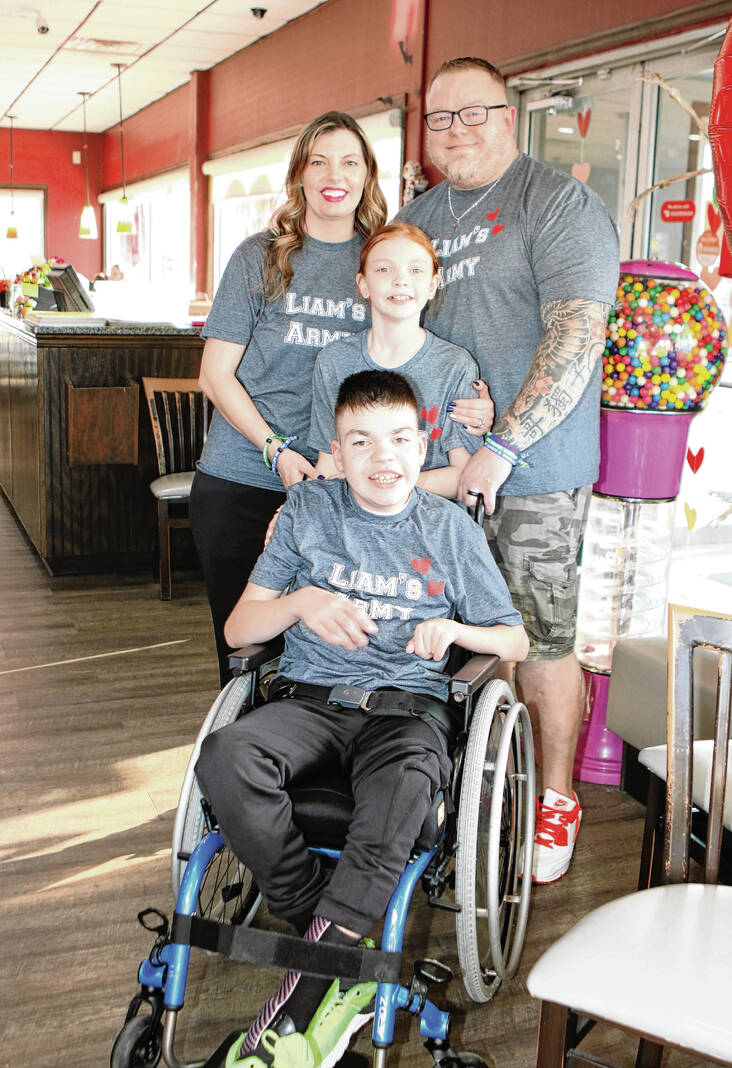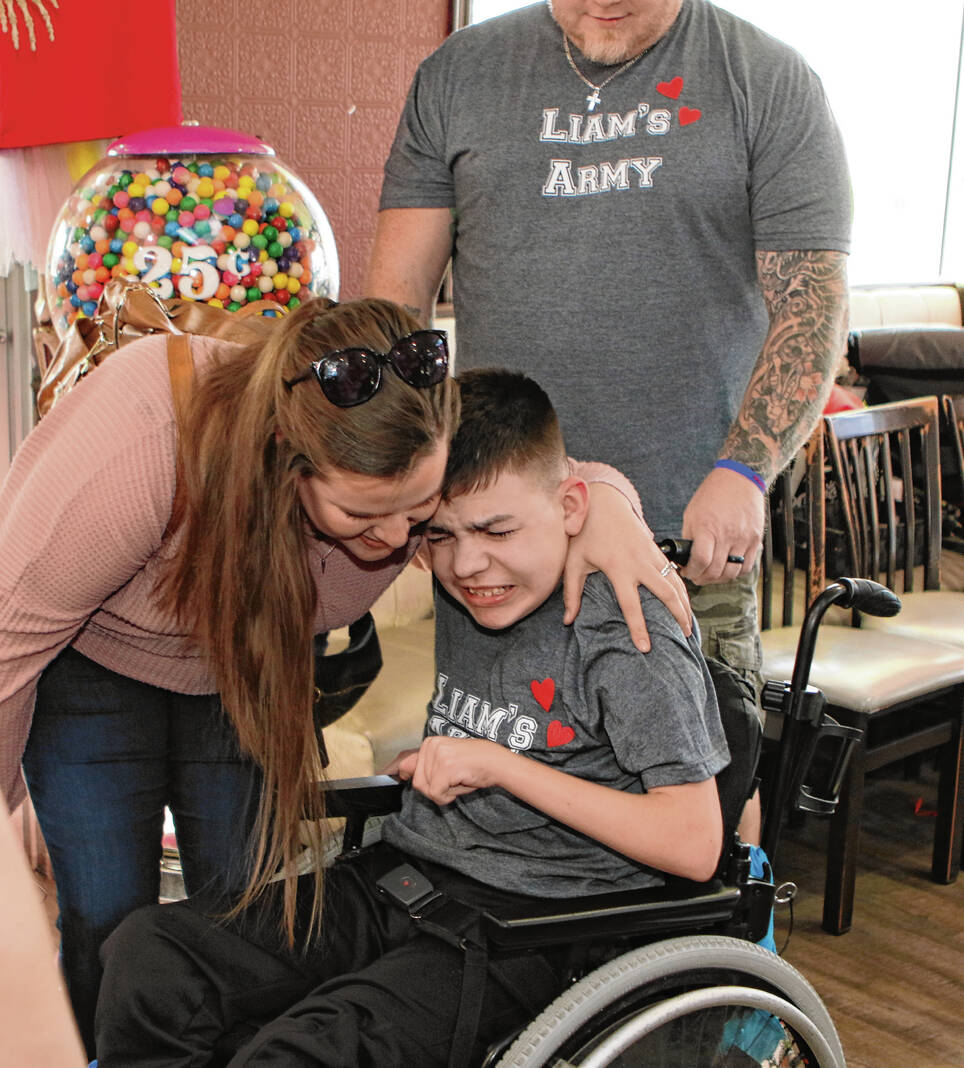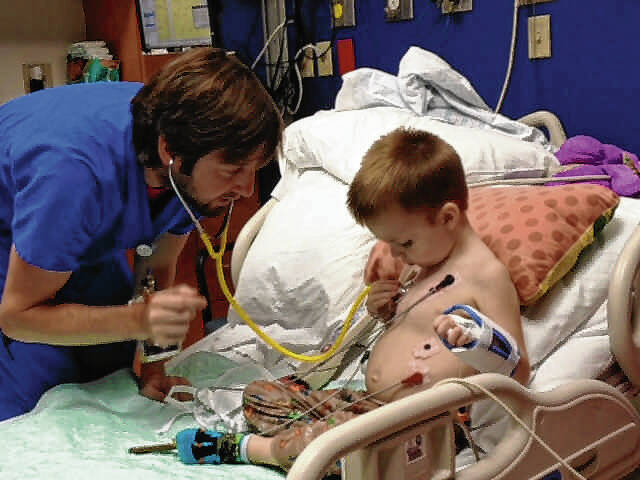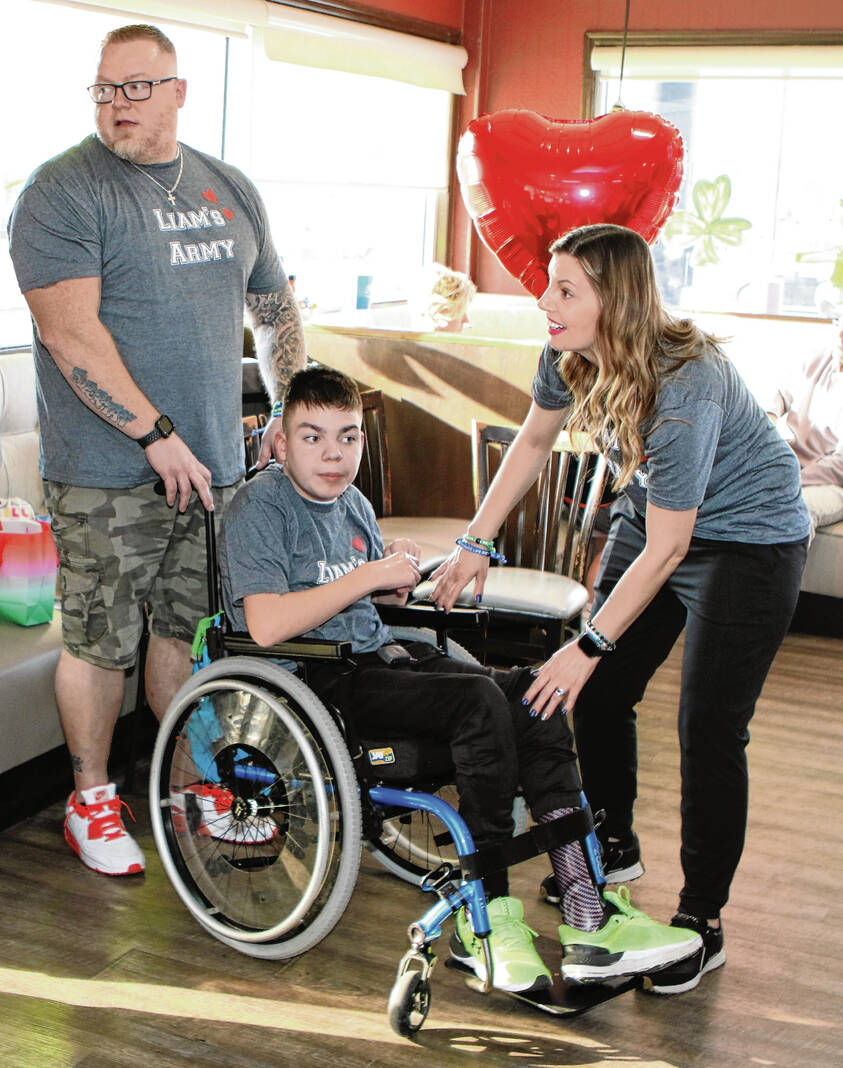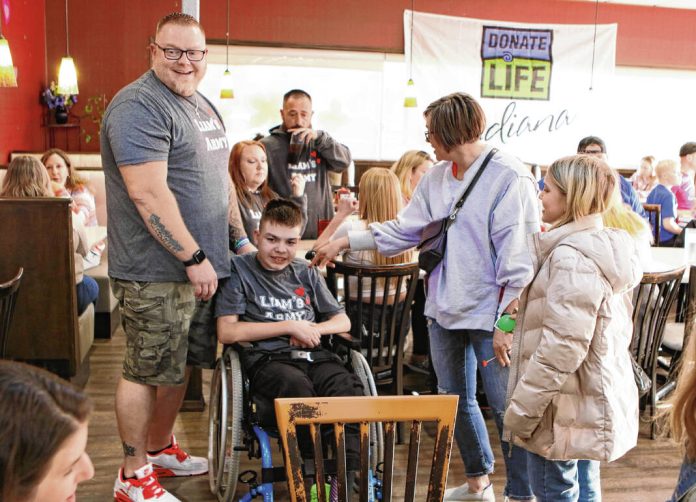
Liam Sprague, 14, greets guests with his father, Richard, at his “heartiversary” celebration on Feb. 25 at Lincoln Square Pancake House in southside Indianapolis. Friends, family and supporters gathered with Liam to recognize 10 years since he received a life-saving heart transplant. SUBMITTED PHOTO
Tragedy united two southside Indianapolis families.
A horrific house fire killed six members of the Guerra family, including four children — one of which was 6-year-old Fuentez. The entire Indianapolis community mourned with them, asking how such a horror could happen.
But in the bleakest moment, young Fuentez was able to provide a final gift of life. His heart was a match for Liam Sprague, who at 4-years-old had been waiting for nearly a year for a transplant.
His donation has given Liam a new life.
“He’s amazing. He’s happy, he’s animated, he doesn’t know a stranger. Basically living life and making memories,” said Carolynn Sprague, Liam’s mom. “We were given a second chance, so we want to do everything we can to live the second chance.”
In the decade since, the Sprague and Guerra families have become close, sharing in the bond of organ donor and recipient. Both have been present to see Liam thrive, making the most out of the precious treasure Fuentez was able to provide him.
In late February, the Sprague family invited the Guerras, as well as more than 150 other people, to gather for what they called Liam’s 10th “heartiversary” — recognizing the day that his life changed course forever.
“We’re lucky we got a chance at another heart. We’re lucky we live in the same state as our donor family and have been able to connect with them,” Carolynn Sprague said.
They hope the stories of Liam and Fuentez help emphasize the vitality of organ donation.
“Tomorrow is not promised. Our tragedy is someone else’s victory,” said David Guerra, Fuentez’s uncle, in a video in 2018 for Indiana Donor Network.
Feb. 22, 2014, remains a dark day in the history of Indianapolis. In the early morning hours, a house fire spread throughout an eastside home. The blaze killed Lionel “Leo” Guerra, 47; Brandy Mae Guerra, 33; Esteban Guerra, 11; and Blanquita Guerra, 8.
Two other children, and Miranda Guerra, 14, and Fuentez, were saved from the fire, but died one day later at Riley Hospital for Children at IU Health.
“They were the ones who were always closest together. That’s how they left this world,” David Guerra said.
At the same time, another family was suffering through a tragedy more than 100 miles away. For more than 300 days, Liam Sprague had been suffering from a severely damaged heart, with a transplant his only treatment.
When Liam was born, he was a happy and healthy baby. His mother described him as “incredibly smart and witty,” she said.
But underneath his seemingly normal exterior, his heart was sick.
Liam was 2 1/2 years old when he developed a nagging cough. It would come and go, Carolynn Sprague said, but never completely went away. Thinking that he may have allergies, his parents took him to the doctor. A chest x-ray showed that Liam’s heart was enlarged, which led them to conduct an electrocardiogram to better analyze his heartbeat.
“The doctor came in and said, ‘Your son has restrictive cardiomyopathy,’ and it’s not a matter of if but when he’ll need a heart transplant,” Carolynn Sprague said in a video for Indiana Donor Network in 2018.
Restrictive cardiomyopathy is the most rare of a series of conditions in which the normal muscle in the heart can thicken, stiffen, thin out or fill with substances the body produces that do not belong in the heart muscle, according to the Centers for Disease Control. As a result, the heart muscle’s ability to pump blood is reduced, which can lead to irregular heartbeats, the backup of blood into the lungs or rest of the body and heart failure.
The condition is genetic, though no one else in the Sprague family has it.
Shortly after the diagnosis, Liam had a cardiac MRI to further investigate the heart, and he went into cardiac arrest.
“Nobody knew how sick his heart was,” Carolynn Sprague said.
Liam was placed on extracorporeal membrane oxygenation, a form of life support for the most severe of heart or lung injuries, and transferred to Cincinnati Children’s Hospital Medical Center. For the next 315 days, he stayed in the hospital waiting for a transplant, supported by his mom, his dad, Richard, and eventually his sister, Amelia, who was born during the ordeal.
“I prayed for it, and then you feel like a horrible person, because all you want is your child to live. But you know that somebody else’s child has to pass for that to happen,” Sprague said in 2018.
On Feb. 25, 2014, the Spragues sensed something had changed. When Carolynn and Richard Sprague came into Liam’s room and found two of his doctors waiting for them. They cautioned that while it was not 100%, it seemed that a transplant match had been found for Liam.
“We hopes, we prayed, family came from Indianapolis to Cincinnati. We took pictures, we did all the things. Then it was official, it would happen the next day. And it did, and it’s been amazing every since,” Carolynn Sprague said.
Back in Indianapolis, the Guerra family was emotionally gutted following the fire. After Miranda and Fuentez died in the hospital, doctors approached them about the potential to be organ donors.
Though it was hard, the Guerras agreed.
“If you can help somebody else, why not?” David Guerra said in the 2018 interview.
The transplant was a success, and Liam has not dealt with any rejection issues since.
Naturally, the family wondered who the family of Liam’s donor had been. Transplant officials warn not to contact the donor family for up to a year; at that point, they could write a letter and request to meet them.
The Guerra family, though, was provided much more information. They knew who had received Fuentez’s donations, and where and when the transplants had occurred.
Through social media, the Spragues connected with David Guerra. He provided a letter that left little doubt that Fuentez’s heart had made Liam’s transplant possible.
“The letter literally said ‘The heart went to a 4-year-old Indianapolis boy residing in Ohio with his mom, dad and baby sister,’” Carolynn Sprague said. “There was no way it could be anyone but us.”
Transplant officials confirmed to each family what they already suspected.
When Liam and his family returned from Cincinnati, friends and family threw them a “welcome home” party in celebration. The Spragues reached out to the Guerra family, starting a connection that had endured.
The link between the Spragues and the Guerras extends further. Through the transplant message boards that Carolynn Sprague found David Guerra on, they learned that another young girl Maren Foster, received a liver transplant at 8 months old at the same hospital Liam was at, on the same day. Fuentez was the donor for her, as well.
In all, the organ donations from the Guerra family following the fire helped more than 20 people in eight states.
During the heart transplant anniversary party on Feb. 25, supporters came to the Lincoln Square Pancake House on the southside of Indianapolis to recognize the significant milestone. Liam’s former physical and occupational therapists, friends and family and supporters came together to honor the now 14-year-old.
Though they were invited, the Guerra family members could not attend, so both families intend to get together soon for their own celebration.
“We just wanted a celebratory event to say, look at him now. Look at what 10 years has done, has given all of us. Look what organ donation can do for a family,” Carolynn Sprague said.
The Spragues had always been organ donors, even before their own family understood just how important being a donor can be. They hope to use their story to emphasize the lives that can change by making the decision.
“The Guerras often say, ‘Even with tragedy, there is hope.’ This is that hope. Yes, you’re going through something that’s absolutely terrible, that no one would wish on anyone,” Carolynn Sprague said. “But you can give somebody else a chance, you can give another family or another parent the ability to not also lose their child or their loved one.”
AT A GLANCE
Organ donation
What kinds of organ donation is there?
Living donation: Kidney and liver patients who can receive a living donor transplant can receive an organ much sooner, often in less than a year.
Deceased donation: Deceased organ, tissue and eye donation is the process of giving an organ (or part of an organ), tissue or eye at the time of the donor’s death, for transplantation to another person. Deceased donors can provide kidneys, liver, heart and valves, lungs, pancreas, intestines, bones, veins, corneas, islet cells and tendons.
Vascularized Composite Allografts: These procedures involve transplant of multiple structures that may include skin, bone, muscles, blood vessels, nerves and connective tissue. The most commonly known type of these are for hand and face transplants.
Who can be an organ donor? Anyone. There are no age or race restrictions for donation, and regardless of medical history, you can sign up to be a donor.
To register to be an organ donor, go to donatelifeindiana.org/show-your-support/sign-up/ and fill out the required form. People also can register to be a donor at any Indiana Bureau of Motor Vehicles location.
To inquire about living donation, go to iuhealth.org/find-medical-services/living-kidney-donation or iuhealth.org/find-medical-services/living-organ-donation.
Source: Donate Life Indiana


